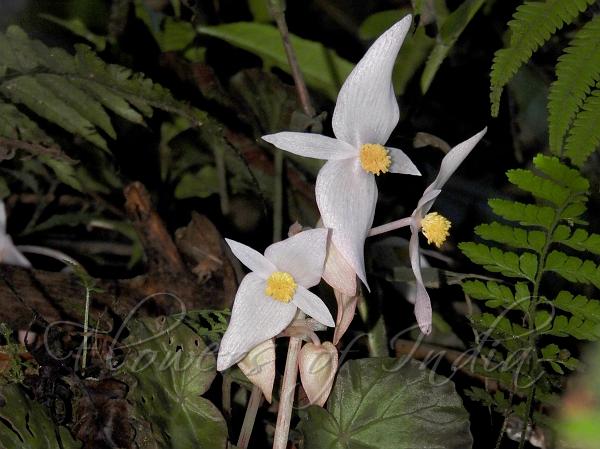|
| White-Cross Begonia |
|

|

| File size | 991641 |
| Original date | 12/29/19 9:14 AM |
| Resolution | 3888 x 5184 |
| Flash | Flash fired, auto, red-eye reduction |
| Focal length | 44.8mm |
| Exposure time | 1/125s |
| Aperture | 5.5 |
| Focus Distance | |
| Metering Mode | Multi-segment |
| Camera make | NIKON |
| Camera model | COOLPIX B700 |
| Sensor type |
|
|
|
|
Photo: |
Botanical name: Begonia burkillii Family: Begoniaceae (Begonia family)
White-Cross Begonia is a perennial herb, 20-40 cm tal,
with rhizome about 1 cm wide. It is named for Isaac Henry Burkill
(1870-1965), an English botanist. Stipules are lanceshaped, 5-17 x 2-7
mm, hairless, persistent. Leaf-stalks are 5-15 cm long, hairless, blade
ovate-lanceshaped to ovate, base heart-shaped with lobes almost
overlapping, 10-20 x 6-9 cm, asymmetric, upper surface variegated green
and brown with a dark centre, hairless or sparsely finely velvet-hairy,
underside variegated red and green, margin entire to shallow toothed,
tip shortly tapering. Flowers are borne in many-flowered cymes in
leaf-axils, flower-cluster-stalk hairless, branching twice, male
primary 5-15 cm, secondary 2-4 cm, 2-6 flowers, female primary 4-6 cm,
1-2 flowers; bracts lanceshaped, 6-20 x 1-5 mm, deciduous. Male flowers
have flower-stalk 1.3-2.5 cm long, hairless; tepals 4; outer tepals
narrowly ovate, 10-30 x 7-16 mm, white to pink, hairless, margin
entire; inner tepals elliptic-obovate, 10-20 x 3-7 mm, white to pink,
hairless; androecium with 40-70 stamens, filaments 1-3 mm long. Female
flowers have stalk hairless; bracteoles absent; tepals 4, similar to
those of the male flower; ovary 4-celled. Capsule is rhomboid, with 4
fleshy triangular wings or ridges; styles 4, forked once and twisted
twice, deciduous. Fruit is carried on a stout stalk, rhomboid; capsule
oblong-ellipsoid, 20 x 4-11 mm, with 4 stubby wings or horns. White-Cross
Begonia is found in Arunachal-Pradesh and Assam; also in Myanmar, at
altitudes of 300-1100 m. Flowering: February-March.
| Identification credit: Momang Taram | Photographed in Pasighat, East-Siang distt, Arunachal Pradesh. |
• Is this flower misidentified? If yes,